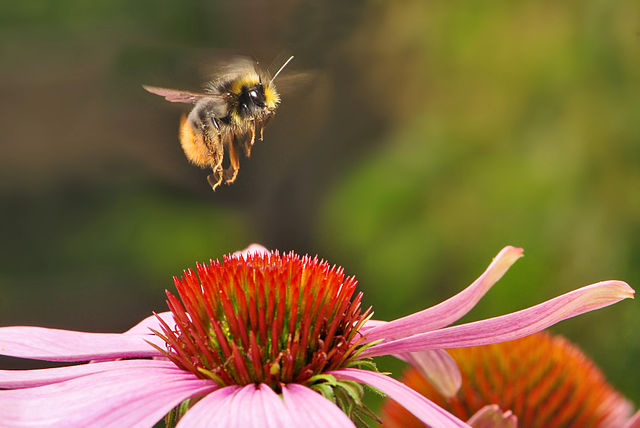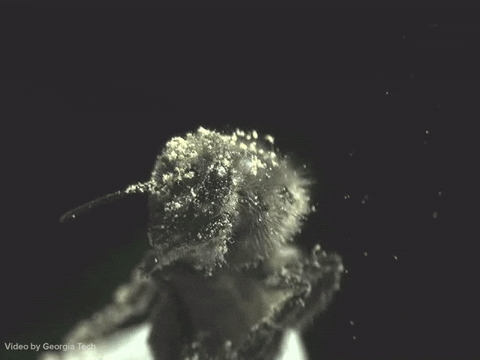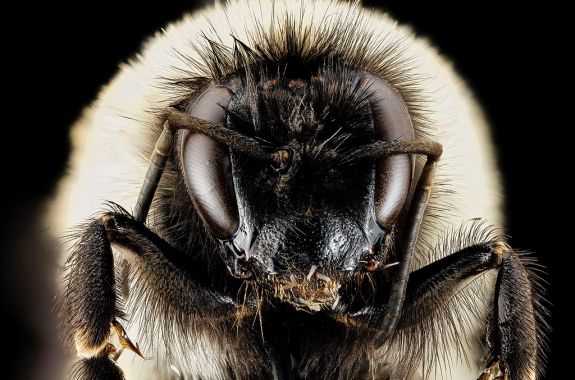Grade Level
3 - 8
minutes
15 min - 1 hr
subject
Physical Science
Activity Type:
making models, forces and motion, structure and function
Picture a big, round, fuzzy bumblebee buzzing around a flower garden, collecting nectar and pollen.

As it approaches the next flower, the bee hovers briefly over the blossom, but even without going in for a closer look, it can tell that this flower has already been visited by another bee. Rather than waste time on an empty bloom, the bee buzzes on in search of a flower that is still full of delicious nectar and pollen.
How can the bumblebee sense which flowers have already been visited? X-ray vision? Telepathy? Not quite–it’s actually a power we can all summon: Static electricity!
In the activities that follow, you will experience and experiment with the static electricity that gives bees this sixth-sense about flowers. All you’ll need is a collection of items made from different materials, a bit of wool or hair, and your imagination!
Bees Can Feel Static Electricity–Just Like You
Bees that buzz around flowers can actually feel whether the flower has been visited by another pollinator by using the hairs on their body to detect something called static charge or static electricity.

Static charge can collect in all kinds of funny places. Anything that moves and comes in contact with another thing can build up a charge, whether that is a helicopter’s spinning blades, pieces of glitter on a tabletop, or the little hairy body of a bumblebee. You can feel static electric charge too! Here’s how:
- Grab a hold of an inflated balloon, a plastic cup, or your favorite polyester sweater, and rub it on your own hair, some wool, or some plastic wrap.
- Hold the balloon or wool close to the skin on your hand or the hairs on your forearm. What does it feel like?
- See if you can feel the hairs on your body move towards the plastic object.
These sensations are as close as you can get to experiencing what it’s like to be a bee arriving at a flower, and it is caused by static charge.
What Is Static Charge?
Static charge is a buildup of positive or negative charges on an object. You can make or generate static charge by rubbing, gliding, or blowing one object against another. When objects are rubbed together, oppositely charged particles, molecules, ions, or electrons can transfer between objects, causing a charge imbalance: One object becomes positively charged, and the other becomes negatively charged.
For example, as you rub that balloon or plastic cup on your head or wool sweater, negatively charged particles move onto the surface of the balloon. Your head gradually becomes positively charged, and the balloon becomes negatively charged. The buildup of opposing charges is static charge. Play with the simulation below to see how positive and negative particles transfer between objects.
Balloons and Static Electricity. Credit: PhET Interactive Simulations
Reflection Questions:
- Reset the simulation with the circle arrow button. What do you notice about the number of positive charges in each object? How does the balloon and the charges in the balloon interact with the wall and the sweater when the positive and negative charges are equal?
- When you rub the balloon on the sweater, which charges move, and where do they go? How does this affect the behavior of the balloon?
- Once you have rubbed the balloon on the sweater, move it over to the wall. What happens to the charges on the wall? Which charges move? How does the balloon interact with the wall?
Objects that are statically charged can push (repel) and pull (attract) other objects with a force called electrostatic force. Electrostatic force works in three ways:
- Like charges (positive-positive or negative-negative) repel one another
Example: The hairs on your head stand up after you rub them with a balloon because they are all similarly charged. - Opposite charges (positive-negative) attract one another
Example: The hairs on your head are attracted to the oppositely charged balloon. - Strong charges attract neutral objects
Example: A charged balloon can attract a plastic bag or stick to a wall. Try this in the simulation above!
You experienced electrostatic force when you felt your hair move in response to the statically charged balloon. Now let’s see if we can statically charge different objects!
First, assemble a collection of items from the following categories:
- Plastic objects like Ping-Pong balls, cups, bags, spoons, wraps, baggies, balloons, sheet protectors, or anything else made out of recyclable plastic.
- Metal objects like aluminum foil, soda cans, foil takeout trays, hangers, or cookie sheets.
- Fabrics or clothes of different materials, such as cotton, wool, polyester, nylon, or silk.
- Tiny bits of other materials like grains of puffed rice, corn cereal flakes, ground pepper, or paper confetti. Collect these on a plate.
Next, get a notebook or piece of paper, a pencil or pen, and start experimenting! Be sure to record the materials you test and your observations as you go.
- Choose any two items that are plastic, metal or fabric.
- Rub the items together. Do they pull or push against each other? Note that on your paper.
- Rub the items together again and hold them over your plate of tiny bits. Do the items exert a force on these tiny pieces of food or paper? How can you tell?
You’ll know that two objects have generated a static charge if you see that they attract or repel each other or other materials—and that’s their electrostatic force at work!
How Does Static Electric Charge Help Bees Collect Pollen?

Like many pollinators, the body of a bumblebee, is covered in millions of tiny hairs. As a bee flaps its wings in flight, these hairs become more and more positively charged. This charge offers the pollen-hungry bee an incredible advantage because pollen is attracted to their statically charged bodies through electrostatic force.

To simulate the bee’s electrostatic force on pollen, use the materials you explored earlier to create a model “bee” and “flower” with “pollen.”
A few helpful tips for making your model:
- Make a “bee” that can be statically charged.
- Choose a material to model “pollen” that gets attracted to and sticks to your “bee.”
- Make a “flower” that holds pollen in a way that allows your “bee” to get near to and attract pollen with static charge.
Once you have selected the materials for your model, act out a bee visiting a flower, explaining how it becomes charged, visits a flower, gets covered in pollen, and flies away. Describe (by talking or writing) what should happen: list out the different materials you have chosen for your model, and note where and how static electric charge plays a role.
Bumblebees Pick Up On The ‘Buzz’ From Flowers
What Happens When A Charged Bee Visits A Charged Flower?
We already know that bees generate static electric charge in flight, but what most people don’t realize is that flowers also carry a charge. By swaying in the breeze, flowers also build up a small negative static electric charge.
So what happens when a positively charged bee touches down on a negatively charged flower? Here, Dr. Gregory Sutton describes the charges on bees and flowers, and how bees perceive that charge:
If you have ever shuffled across a carpeted floor and gotten a zap from a doorknob or accidentally shocked another person, you’ve felt another side effect of static electric charge: static discharge. Charged particles will flow quickly between objects with different charges if they get close enough to one another. The flow of charge creates a sudden current of electricity large enough to shock someone!
After static discharge occurs, the two objects will carry neutral charges (neither positive or negative). If you want to experiment with electrostatic discharge but don’t want to shuffle across a carpet and get zapped, you can play with the John Travoltage simulation below:
John Travoltage, PhET Simulations
A small static discharge might not even be noticeable, but really big static discharges can transfer enough charge that it can be dangerous. For example, helicopters flying in dusty or sandy conditions can build up such an extraordinary amount of static electricity that responders repelling from rescue helicopters can get a dangerous shock when they reach the ground!
For bees and flowers though, the amount of static discharge is so small that neither the flower, nor the bee, gets hurt. But when the bee detects no charge in a flower, it knows that the bloom has already been visited by another pollinator and it will fly off to look for food elsewhere.
In the full interview below, listen to a pair of scientists describe how they discovered the hidden, statically charged world of bumblebees and flowers, and learn more about how bees use this information to gather nectar and pollen without wasting any time.
Next Generation Science Standards
3-PS2-3: Ask questions to determine cause and effect relationships of electric or magnetic interactions between two objects not in contact with each other.
4-LS1-2: Use a model to describe that animals receive different types of information through their senses, process the information in their brain, and respond to the information in different ways.
Science and Engineering Practices: Developing and Using Models, Asking Questions and Defining Problems
Credits
Written by Ariel Zych
Digital Production by Ariel Zych, Johanna Mayer, and Xochitl Garcia
Editing by Abigail Holstein
Meet the Writer
About Ariel Zych
@arieloquentAriel Zych is Science Friday’s director of audience. She is a former teacher and scientist who spends her free time making food, watching arthropods, and being outside.
